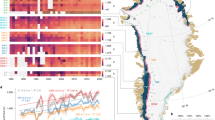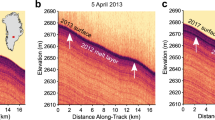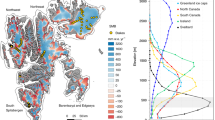Abstract
In recent decades, meltwater runoff has accelerated to become the dominant mechanism for mass loss in the Greenland ice sheet1,2,3. In Greenland’s high-elevation interior, porous snow and firn accumulate; these can absorb surface meltwater and inhibit runoff4, but this buffering effect is limited if enough water refreezes near the surface to restrict percolation5,6. However, the influence of refreezing on runoff from Greenland remains largely unquantified. Here we use firn cores, radar observations and regional climate models to show that recent increases in meltwater have resulted in the formation of metres-thick, low-permeability ‘ice slabs’ that have expanded the Greenland ice sheet’s total runoff area by 26 ± 3 per cent since 2001. Although runoff from the top of ice slabs has added less than one millimetre to global sea-level rise so far, this contribution will grow substantially as ice slabs expand inland in a warming climate. Runoff over ice slabs is set to contribute 7 to 33 millimetres and 17 to 74 millimetres to global sea-level rise by 2100 under moderate- and high-emissions scenarios, respectively—approximately double the estimated runoff from Greenland’s high-elevation interior, as predicted by surface mass balance models without ice slabs. Ice slabs will have an important role in enhancing surface meltwater feedback processes, fundamentally altering the ice sheet’s present and future hydrology.
This is a preview of subscription content, access via your institution
Access options
Access Nature and 54 other Nature Portfolio journals
Get Nature+, our best-value online-access subscription
$29.99 / 30 days
cancel any time
Subscribe to this journal
Receive 51 print issues and online access
$199.00 per year
only $3.90 per issue
Buy this article
- Purchase on SpringerLink
- Instant access to full article PDF
Prices may be subject to local taxes which are calculated during checkout



Similar content being viewed by others
Data and code availability
Firn cores presented in Extended Data Fig. 1 are available in the 2018 release of Greenland’s SumUp dataset32. Post-processed GPR and IceBridge AR transects, shapefiles and CSV-summaries are publicly available in Figshare project ‘Greenland Ice Slabs Data’ at https://doi.org/10.6084/m9.figshare.8309777. Codes for post-processing core, GPR, IceBridge AR and RCM data are available at https://github.com/mmacferrin/Greenland_Ice_Slabs. RCM outputs are available from the respective online data repositories for each model and/or upon request from the authors. Greenland boundary outlines used in all maps are available from the Natural Earth open-access GIS repository at https://www.naturalearthdata.com/downloads/.
References
van den Broeke, M. R. et al. On the recent contribution of the Greenland ice sheet to sea level change. Cryosphere 10, 1933–1946 (2016).
Fettweis, X. et al. Reconstructions of the 1900–2015 Greenland ice sheet surface mass balance using the regional climate MAR model. Cryosphere 11, 1015–1033 (2017).
Mottram, R. et al. An integrated view of Greenland ice sheet mass changes based on models and satellite observations. Remote Sens. 11, 1407 (2019).
Harper, J., Humphrey, N., Pfeffer, W. T., Brown, J. & Fettweis, X. Greenland ice-sheet contribution to sea-level rise buffered by meltwater storage in firn. Nature 491, 240–243 (2012).
Machguth, H. et al. Greenland meltwater storage in firn limited by near-surface ice formation. Nat. Clim. Chang. 6, 390–393 (2016).
Mikkelsen, A. B. et al. Extraordinary runoff from the Greenland ice sheet in 2012 amplified by hypsometry and depleted firn retention. Cryosphere 10, 1147–1159 (2016).
Nghiem, S. V. et al. The extreme melt across the Greenland ice sheet in 2012. Geophys. Res. Lett. 39, L20502 (2012).
Tedesco, M. et al. Evidence and analysis of 2012 Greenland records from spaceborne observations, a regional climate model and reanalysis data. Cryosphere 7, 615–630 (2013).
Benson, C. S. Stratigraphic Studies in the Snow and Firn of the Greenland Ice Sheet. Research Report No. 70 (US Army Snow, Ice and Permafrost Research Establishment, 1962).
Brown, J., Harper, J., Pfeffer, W. T., Humphrey, N. & Bradford, J. High-resolution study of layering within the percolation and soaked facies of the Greenland ice sheet. Ann. Glaciol. 52, 35–42 (2011).
Heilig, A., Eisen, O., MacFerrin, M., Tedesco, M. & Fettweis, X. Seasonal monitoring of melt and accumulation within the deep percolation zone of the Greenland Ice Sheet and comparison with simulations of regional climate modeling. Cryosphere 12, 1851–1866 (2018).
Humphrey, N. F., Harper, J. T. & Pfeffer, W. T. Thermal tracking of meltwater retention in Greenland’s accumulation area. J. Geophys. Res. 117, F01010 (2012).
Sommers, A. N. et al. Inferring firn permeability from pneumatic testing: a case study on the Greenland ice sheet. Front. Earth Sci. 5, 20 (2017).
Forster, R. R. et al. Extensive liquid meltwater storage in firn within the Greenland ice sheet. Nat. Geosci. 7, 95–98 (2014).
Miège, C. et al. Spatial extent and temporal variability of Greenland firn aquifers detected by ground and airborne radars. JGR Earth Surf. 121, 2381–2398 (2016).
Munneke, P. K. M., Ligtenberg, S. R., van den Broeke, M. R., van Angelen, J. H. & Forster, R. R. Explaining the presence of perennial liquid water bodies in the firn of the Greenland Ice Sheet. Geophys. Res. Lett. 41, 476–483 (2014).
Hanna, E., Fettweis, X. & Hall, R. J. Recent changes in summer Greenland blocking captured by none of the CMIP5 models. Cryosphere 12, 3287–3292 (2018).
Pfeffer, W. T., Meier, M. F. & Illangasekare, T. H. Retention of Greenland runoff by refreezing: implications for projected future sea level change. J. Geophys. Res. 96, 22117–22124 (1991).
Braithwaite, R. J., Laternser, M. & Pfeffer, W. T. Variations of near-surface firn density in the lower accumulation area of the Greenland ice sheet, Pâkitsoq, West Greenland. J. Glaciol. 40, 477–485 (1994).
Charalampidis, C. et al. Changing surface–atmosphere energy exchange and refreezing capacity of the lower accumulation area, West Greenland. Cryosphere 9, 2163–2181 (2015).
van As, D. et al. Hypsometric amplification and routing moderation of Greenland ice sheet meltwater release. Cryosphere 11, 1371–1386 (2017).
Rennermalm, A. K. et al. Evidence of meltwater retention within the Greenland ice sheet. Cryosphere 7, 1433–1445 (2013).
Trusel, L. D. et al. Nonlinear rise in Greenland runoff in response to post-industrial Arctic warming. Nature 564, 104–108 (2018).
Fitzpatrick, A. A. W. et al. A decade (2002–2012) of supraglacial lake volume estimates across Russell Glacier, West Greenland. Cryosphere 8, 107–121 (2014).
Poinar, K. et al. Limits to future expansion of surface-melt-enhanced ice flow into the interior of western Greenland. Geophys. Res. Lett. 42, 1800–1807 (2015).
Phillips, T., Rajaram, H. & Steffen, K. Cryo-hydrologic warming: a potential mechanism for rapid thermal response of ice sheets. Geophys. Res. Lett. 37, L20503 (2010).
MacGregor, J. A. et al. A synthesis of the basal thermal state of the Greenland Ice Sheet. J. Geophys. Res. Earth Surf. 121, 1328–1350 (2016).
Doyle, S. H. et al. Persistent flow acceleration within the interior of the Greenland Ice Sheet. Geophys. Res. Lett. 41, 899–905 (2014).
Bevis, M. et al. Accelerating changes in ice mass within Greenland, and the ice sheet’s sensitivity to atmospheric forcing. Proc. Natl Acad. Sci. USA 116, 1934–1939 (2019).
van As, D. et al. Reconstructing Greenland Ice Sheet meltwater discharge through the Watson River (1949–2017). Arct. Antarct. Alp. Res. 50, S100010 (2018).
Porter, C. et al. ArcticDEM https://doi.org/10.7910/DVN/OHHUKH (Harvard Dataverse, 2018).
Montgomery, L., Koenig, L. & Alexander, P. The SUMup dataset: compiled measurements of surface mass balance components over ice sheets and sea ice with preliminary analysis over Greenland. Earth Syst. Sci. Data 10, 1959–1985 (2018).
Leuschen, C. IceBridge Accumulation Radar L1B Geolocated Radar Echo Strength Profiles (National Snow and Ice Data Center, 2014).
Howat, I. M., Negrete, A. & Smith, B. E. The Greenland Ice Mapping Project (GIMP) land classification and surface elevation data sets. Cryosphere 8, 1509–1518 (2014).
Koenig, L. S. et al. Wintertime storage of water in buried supraglacial lakes across the Greenland Ice Sheet. Cryosphere 9, 1333–1342 (2015).
Doyle, S. H. et al. Amplified melt and flow of the Greenland ice sheet driven by late-summer cyclonic rainfall. Nat. Geosci. 8, 647–653 (2015).
Langen, P. L., Fausto, R. S., Vandecrux, B., Mottram, R. H. & Box, J. E. Liquid water flow and retention on the Greenland Ice Sheet in the regional climate model HIRHAM5: local and large-scale impacts. Front. Earth Sci. 4, 110 (2017).
Christensen, O. et al. The HIRHAM Regional Climate Model Version 5 (Beta). Technical Report No. 06-17 (Danish Meteorological Institute, 2007).
Dee, D. P. et al. The ERA-Interim reanalysis: configuration and performance of the data assimilation system. Q. J. R. Meteorol. Soc. 137, 553–597 (2011).
Kalnay, E. et al. The NCEP/NCAR 40-year reanalysis project. Bull. Am. Meteorol. Soc. 77, 437–471 (1996).
Hazeleger, W. et al. EC-Earth: a seamless Earth-system prediction approach in action. Bull. Am. Meteorol. Soc. 91, 1357–1364 (2010).
Chylek, P., Li, J., Dubey, M. K., Wang, M. & Lesins, G. Observed and model simulated 20th century Arctic temperature variability: Canadian Earth System Model CanESM2. Atmos. Chem. Phys. Discuss. 2011, 22893–22907 (2011).
Watanabe, M. et al. Improved climate simulation by MIROC5: mean states, variability, and climate sensitivity. J. Clim. 23, 6312–6335 (2010).
Bentsen, M. et al. The Norwegian Earth System Model, NorESM1-M – Part 1: description and basic evaluation of the physical climate. Geosci. Model Dev. 6, 687–720 (2013).
Collins, W. J. et al. Evaluation of the HadGEM2 Model. Technical Note No. 74 (Met Office, Hadley Centre, 2008).
IPCC. Climate Change 2013: The Physical Science Basis (eds Stocker, T. F. et al.) (Cambridge Univ. Press, 2013).
Acknowledgements
We acknowledge National Aeronautics and Space Administration (NASA) awards NNX10AR76G and NNX15AC62G for funding most of the work, including field campaigns. This work was also supported by the Retain project, funded by the Danish Council for Independent Research (grant number 4002-00234). Research leading to these results received funding from the European Research Council under the European Union’s Seventh Framework Programme (FP7/2007-2013)/ERC grant agreement 610055 as part of the ice2ice project. We thank the field team members for their contributions to field data collection in 2012–2017.
Author information
Authors and Affiliations
Contributions
M.MF. conceived the study question, processed the core, GPR and IceBridge AR data, post-processed the RCM output data and is the primary author of the manuscript and supplement. All authors contributed to the manuscript text, analyses, figures and revisions. M.MF., H.M., and D.v.A. planned, organized and undertook field campaigns dedicated to the data presented in this paper. C.C., C.M.S., B.V. and A.H. collected, interpreted and/or plotted field data. P.L.L., R.M., X.F. and M.R.V.d.B. provided regional climate model outputs and assisted with their results and interpretations. W.T.P. helped formulate and interpret the excess melt model. M.S.M. performed remote-sensing validation of runoff over ice slabs. W.A. supervised and oversaw the direction and formulation of the manuscript and project.
Corresponding author
Ethics declarations
Competing interests
The authors declare no competing interests.
Additional information
Publisher’s note Springer Nature remains neutral with regard to jurisdictional claims in published maps and institutional affiliations.
Extended data figures and tables
Extended Data Fig. 1 Firn core density profiles.
Firn density is plotted in black with ice layers indicated in blue. a, Firn cores drilled during the ACT-13 campaign5. b, A time series of firn core measurements at the KAN_U field site; data obtained in 2009–2017. c, Firn cores from the BAB_U field site, 40 km southeast of KAN_U, measured in 2015 and 2017.
Extended Data Fig. 2 Map of core locations.
IceBridge flight lines are shown in light blue and 50-m-elevation contours in grey, derived from ArcticDEM dataset31. KAN_U, at an elevation of 1,840 m, is identified on the left. IceBridge flight lines that overlap core locations are highlighted in orange.
Extended Data Fig. 3
RCM calculations of excess melt in pixels in which ice slabs are detected by IceBridge AR data.
Extended Data Fig. 4 Simulated ice slabs in Greenland drainage basins.
a, Area (×103 km2; top) and mean elevation (in metres, ±1 s.d.; bottom) of ice slabs, as detected by IceBridge AR and simulated by RCMs, around 2014. b, Ice slabs simulated using RACMO ERA-Int 2014 model results in each drainage basin.
Supplementary information
Supplementary Information
Text and figures describing the GPR and IceBridge AR processing steps used in the main manuscript (Fig. 2).
Supplementary Table 3
List of derived empirical formula variables for the roll-correction parameters of every IceBridge AR track (Supplementary section S.2.3.2).
Source data
Rights and permissions
About this article
Cite this article
MacFerrin, M., Machguth, H., As, D.v. et al. Rapid expansion of Greenland’s low-permeability ice slabs. Nature 573, 403–407 (2019). https://doi.org/10.1038/s41586-019-1550-3
Received:
Accepted:
Published:
Issue Date:
DOI: https://doi.org/10.1038/s41586-019-1550-3



